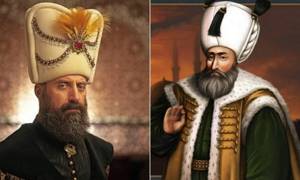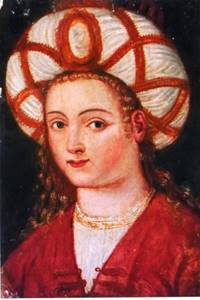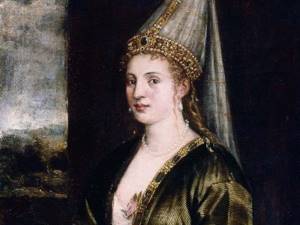Sultanas of VV
8219
A little more than 500 years have passed since a young, thin, red-haired girl was torn away from her family, put on a ship as a prisoner and taken across the sea to a country that was foreign to her. Then it was not just a kidnapping, but a real murder. And there were a lot of such stories back then. Many girls were kidnapped this way.
The captives were brought to Istanbul to the slave market. There they became slaves. In this market of living souls, slaves of two categories were sold. The first group included girls and women, who were then bought as servants, to do menial work, or they ended up in a harem of not the richest people. The only clothing they wore was an iron collar, which cut into their flesh. The second category included attractive young girls who were destined to become a toy for the carnal pleasures of a rich gentleman. The girls were well looked after and dressed beautifully. These girls were more expensive and were sold in a separate pavilion. Girls were also bought here for the Sultan's harem. It was here that a 15-year-old Ukrainian girl ended up, who did not burst into tears, but rather laughed all the time.
The slave traders, accustomed to seeing grief and despair in the eyes of their slaves, were in great amazement. Usually they heard crying and cursing, but not laughter. And for the unfortunate Roksolana this was the only salvation from the iron collar. That's why she laughed and didn't lower her eyes. Roxlona was buried alive in the harem. And instead of her, another girl appeared, whom the history of the Ottomans remembered as Hurrem. The girl's real name became a thing of the past and was forgotten forever. Roksolana was only 15 years old when the huge doors of the Ottoman harem slammed behind her forever.
Plot (film) about Hurrem Sultan

The most popular creative mention of Hurrem Sultan turned out to be the series “The Magnificent Century”. In it, the cause of the woman’s death was a serious illness – cancer. This version is not confirmed, but at the same time it is not refuted.
The series “The Magnificent Century” describes in detail scenes from the life of a woman. Her demise is shown in episode 134. The woman will die in the arms of her husband, who will read poetry to her at the moment of death. The film fully conveys the painful events of Hurrem's life.
Roskolana is the name that the woman had before meeting Suleiman.
There is a legend that says that one of the high-ranking officials gave Roskolan to Suleiman. Just at this time he was preparing to ascend the throne.
After the girl has received a place in the harem, she takes a decisive step. Converts to Islam and acquires a new name - Hurrem. Her character was very assertive, thanks to which the woman achieves success in the future. It was with her individuality that she was able to truly endear herself to the Sultan and win him over.
Sultan Suleiman the Magnificent

The date of birth of the greatest ruler is November 6, 1494.
On September 22, 1522, he became the tenth Sultan of the Ottoman Empire. During the years of his reign, he conquered a huge number of fortresses and cities. He subjugated entire states.
His greatest love was Hurrem Sultan, with whom he performed nikah and gave her the title - Haseki.
On the last campaign , on September 6, 1566, Suleiman passed away.
A story from the life of Hurrem Sultan
When the harem girls demonstrated their talents, the woman pushed one of them away and laughed loudly. Afterwards she began to sing. Show your abilities. This trick did not seem ignorant to Suleiman, quite the contrary, it was precisely such manipulations that made him fall in love with her. After that, Suleiman gave her his scarf. This was some kind of sign that promised an invitation to spend a night together.
Currently, part of the correspondence between Hurrem and Suleiman has been preserved. They describe their love feelings, complete reciprocity.

They say that the girl was so creative and capable that she easily learned different languages and could calmly talk with Suleiman on various topics.
But soon Hurrem had a rival who gave birth to a son for the Sultan, calling him Mustafa. The girls couldn't stand each other. Therefore, quarrels and conflicts arose between them. There was an eternal war for the heart of a man, as well as for the right to the throne of the future heir to the throne.
But Alexandra Anastasia Lisowska was a difficult girl. She did not want to share Suleiman. By cunning, she made sure that the Sultan sent her rival to his son.
Probably, in order to remain in power, Hurrem gave birth to five children to Suleiman. Four of them were boy heirs who continued the dynasty. The woman made a kind of record by giving birth to five children in 5 years. It was incredibly difficult because childbirth in those days was difficult and exhausting (complicated).

10 years after their first meeting, Suleiman freed the woman from slavery, for which she, in gratitude, gave birth to another, sixth son.
The Sultana was so eager for power that it destroyed her children. Her manipulations were wasteful. Hurrem made sure that the Sultan ordered the murder of his own son, Mustafa, who was born from a previously expelled rival. This made it possible to retain the right to the throne for one of her sons. But then the unthinkable happened. A real war for the throne broke out between the brothers. As a result, Selim received the right to the throne, who, as history has shown, became one of the weakest rulers.
Alexandra Anastasia Lisowska's whole life and her biography are similar to the fairy tale about Cinderella. The same story - unique and mysterious. She became the first concubine of her kind that the Sultan wanted to marry. Their family unit was formed in 1530. The Sultan was so imbued with his love for her that he even gave her a dowry as a gift. After this, the sultana bore the great title “Haseki,” which spoke of her difficult origins.
Reviews and responses to the series
The soap opera about life in the Sultan's palace had become obsolete by the end of the second season.
The series about the Ottoman Sultan Suleiman I and his Ukrainian concubine and later wife Alexandra caused a storm of protests regarding the believability and historical accuracy of the plot. Turkish television received tens of thousands of complaints about “factual errors,” crowds of tourists protested outside the responsible studio, outraged by the distortion of history, and Prime Minister Recep Tayyip Erdogan said that the series instills in young people the wrong idea about their ancestors. In fact, the creators of the series did not claim any authenticity and stubbornly answer all questions that they warned everyone from the very beginning: the series is only inspired by historical events.
For those who have not seen the series, all this talk about history can be confusing, but the first episodes put everything in its place: “The Magnificent Century” is a classic soap opera and is written according to the laws of the genre, and not history, which only from time to time intrudes into the world of harem intrigues - always at the most inopportune moment. Nevertheless, we can only congratulate the authors of the series for choosing Suleiman’s harem as the setting: millions of viewers ignored the distortions of facts, opting for a fictional story of family intrigue in luxurious interiors. The magnificent blue robe of Sultan Suleiman with a gold pattern is the answer to the question of why Suleiman I himself turned from an enlightened but tough tyrant in a disproportionate headdress into a kind-hearted father of a family with a sad look and a beautifully styled beard.
The magnificent robe, like the dresses and crowns of the concubines, which have lost all connection with the historical prototypes, declares from the first frames the fabulousness of what is happening on the screen: the Sultan’s mother is the evil queen from Snow White, and his sister and concubines, Alexandra’s competitors, are Cinderella’s envious sisters. All the concubines are incredibly beautiful, the children are touching, and the mystical dreams are filmed with grandiose special effects for a soap opera. Unfortunately, the authors did not find the courage to fully adhere to the stated course and completely abandon the connection to history. As a result, when by the end of the second season all plausible options for the development of events in the harem end, all that remains is to repeat what has been done with minimal changes. All the characters are poisoned several times, mutual threats are predictable, dialogues are repeated from episode to episode (“who are you to tell me?”). By the third season, even the most inattentive viewer knows how, as a simple concubine, to forever capture the heart of a fictional sultan: the algorithm of actions is very simple, but it works over and over again, so that it has become a routine. Basically, there is some irony in this.
This review will be a truthful look at the series, taking into account all the nuances and small details. The Magnificent Century is a series about the Middle Ages, about the century of Sultan Suleiman. According to viewers, the series received high fame. Of course, the series was filmed at the highest level, the outfits, the palace, almost everything is depicted, as in the old days. I haven’t watched the whole series, I still have a little less than half a hundred episodes to watch, but I can already draw many conclusions. Let's start with the plot, depicted by the directors *from their own angle* - It's complete nonsense, the directors didn't try a bit when finalizing the characters and their scripts, it's complete nonsense and the implementation of the dialogues simply can't help but drive you crazy, but the presentation of the series is at the highest level, there's no point in arguing here . The whole problem is that the series is a category of fiction, the things depicted in the series do not take place in reality, using history, they *distorted* and recreated a false *parody* of the age of Sultan Suleiman. The relationships are so implausible and ridiculous that throughout the entire series I want to turn it off and not watch it again, which I did repeatedly. Hurem, the wife of the Sultan, is the queen and queen of the world, the Sultan fulfills any of her requests and orders without objection, and by fulfilling it, he thought that he was in control of everything. Khyurem, rules so recklessly the entire garom, the sultan and most of the sultanas. The fact is that the devotion shown arose out of nothing, the character simply appeared in the series and immediately *creeps* under Khyurem, and there is no end to this. Valide, the mother of the Sultan, disliked Khyurem initially, and then, Khyurem began openly, without hesitation, to insult and humiliate her, threaten to kill her or get rid of her, and after a few episodes Valide again communicates with her as a friend, and even the point is not that she can specifically be friends with Khyurem for her own benefit, but that Khyurem came - she lied - and Valide melted from the extraordinary lie. The series is full of such situations, when Hyurem, being in a huge quarrel, in a second turns an enemy into a friend with a complete lie, and then again into an enemy - and so on five times with each character, and all of them are conducted like the first time!! I, a person who looks carefully, can see this very well, and I don’t need to delve into every episode to say: “What nonsense! She just threatened to kill you, and now you have become her best friend. “In general, the series was beautifully filmed, presented perfectly and went well with the audience, BUT the implementation of the dialogues, the implementation of that time and those people in history is complete nonsense! The only thing that seems nonsense in the series, but one can understand it, is the Sultan’s love for Hyurem, no matter what they report to him about her, no matter what evidence is presented, he will be on her side, although he tells everyone that he is dispensing justice! But he loves her endlessly and irrevocably, therefore, this can at least somehow be justified, although, of course, I have never seen anything more delusional. Rating 3/5
Activities of Hurrem Sultan

Alexandra Anastasia Lisowska became a real ruler. She participated in the life of the empire, making various fateful decisions. She tried to establish close relations with other countries and looked for new ways to replenish the treasury. The woman fulfilled her obligations to the state. Her spending was quite reasonable. She was involved in charity work, and with money donated by the Sultan, she built several schools, hospitals, and mosques.
But people’s attitude towards her is still ambiguous due to the actions of her entire life. Her character is not the norm for a Muslim girl. And her intrigues and conspiracies presented her as the most controversial figure in the history of that century.
Death of Hurrem Sultan
The farewell ceremony for Hurrem after her death took on a large scale. And this is not at all surprising, because she was the wife of Ruler Suleiman, the love of his life. And later she became a person who wrote her name on the pages of history.

Where is Hurrem buried? She was buried in the courtyard of one of the Suleymaniye mosques. A mausoleum was specially built for the woman. This mosque can accommodate five thousand people. It is the largest in size and second in importance in the whole world.
After the death of his wife, 8 years later Suleiman himself died. Perhaps, if not for the death of his wife, the Sultan would have lived much longer. But the melancholy overtaken by lost love broke the unshakable man. Suleiman was buried in the same mosque. Also in the mausoleum built for him.
In addition to Suleiman himself, his close relatives rest in the tomb. His beloved is nearby. Although Hurrem's tomb is distinguished by its splendor, Suleiman's is much more beautiful. A large number of streams of light falling directly from heaven, wall paintings, magnificent tombs - the resting place of the Sultan. This was done in order to emphasize his status.

Why weren't they buried together? There are several reasons. For one of them, theologians do not recommend burying more than one person in a grave, and for the second reason - the situation. If Hurrem had died later, they might have been placed next to each other, but Suleiman’s position (as Sultan) does not allow him to be buried in his wife’s turban. These are the traditions and rules.
Here is such a mysterious mysterious story, shrouded in darkness and love. According to sources of information that have reached us, it can be argued that their love was one of the strongest and most sincere. Alexandra Anastasia Lisowska was not only able to win Suleiman’s heart one fine day, she bewitched him, which turned the destinies of both of them upside down. Love is quite unpredictable, and sometimes insidious.











